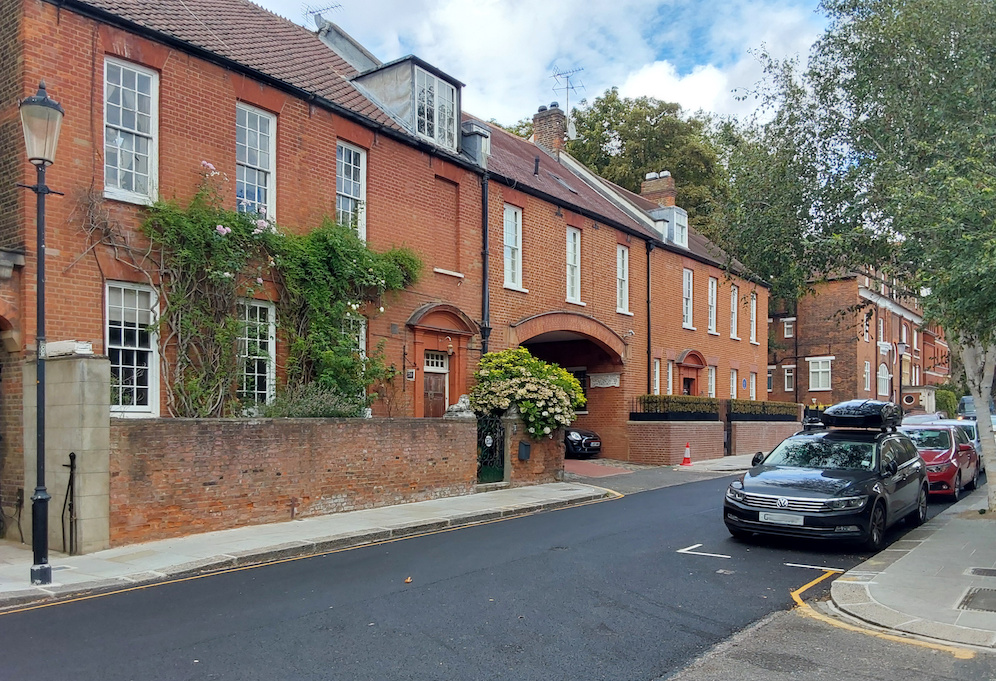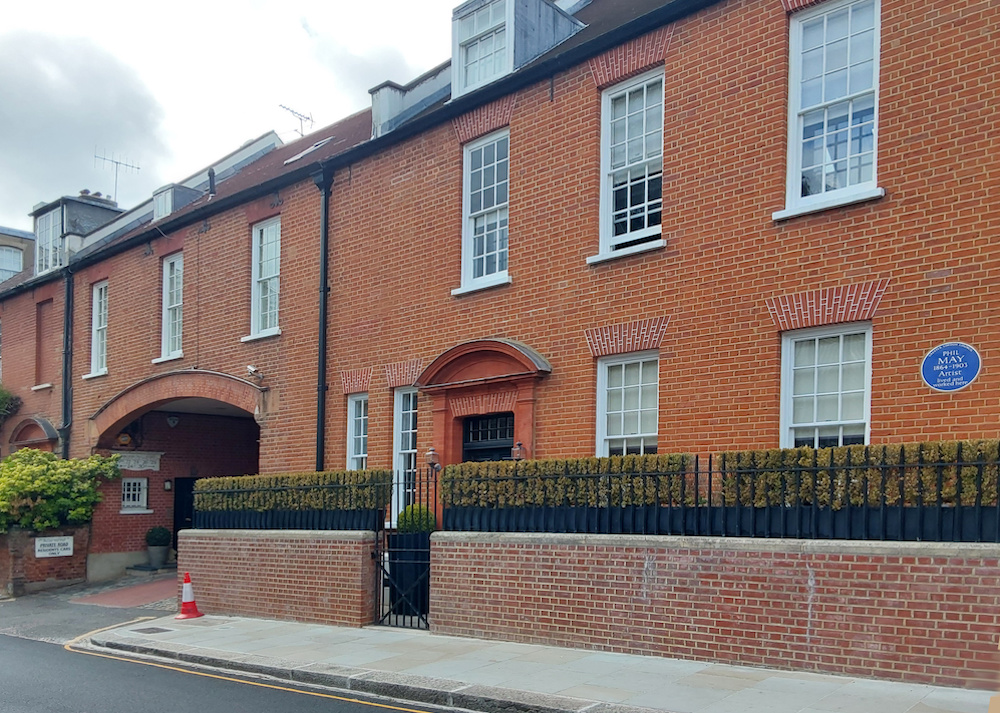
Studio houses on Holland Park Road, built by Arthur Langdale and Co., Brompton. 1878-79. Grade II listed. Described in the listing text as "Six 2-storey studio residences arranged round a courtyard with arched entrance. Brick, gauged arches, tiled roofs."
Background
In 1866 Frederic Leighton and Val Prinsep built studio houses with substantial gardens on the north side of Holland Park Road, in what was formerly part of the Holland House estate. West of Prinsep's house another plot was occupied by a charity school set up in 1842 by Caroline Fox, one of Lord Holland's sisters. But the school moved to another site, leaving its old one to be bought up in 1877 by a developer. Caroline Daker states that this was William Willett (1856-1915), a builder from Hove on the south coast, suggesting that he had a sharp eye for the benefits of an address so close to Leighton, who had only recently been promoted to President of the Royal Academy. As a result, the old buildings were replaced in 1879 by "the picturesque group of six two-storey studio residences arranged round a courtyard with an arched entrance, originally simply called 'The Studios' and now Nos. 20-30 (even) Holland Park Road" (Sheppard). According to the Survey of London, and to a conservation draft of more recent years, these were actually built by Arthur Langdale and Co., Brompton (Holland Park Conservation Area Appraisal 75), possibly as sub-contractor.
The Artists in Occupancy

This view shows the blue plaque to the cartoonist and illustrator Phil May, who moved in after Henrietta Rae and Ernest Normand left.
As expected, the studio leases were soon taken up by aspiring artists. The most notable were Herbert Gustave Schmalz (1856-1935) at number 5, William Blake Richmond at number 6, and from 1885 the husband and wife artists Ernest Normand and Henrietta Rae at number 3. It was a real community. Henrietta, for example, grew very attached to her neighbour Prinsep and named her son, born 1886, Rae Prinsep Normand. However both Prinsep and Leighton liked to dispense wise advice, so much so that by 1893 the couple felt obliged to move away to escape their influence: "Rae had become so incensed by Prinsep's incessant interference that she had thrown his hat on her stove; on another occasion she threw it out of the window" (Dakers 220). The birth of a daughter also gave impetus to their move to larger premises in Upper Norwood, where studio space was greater, and where they spent the rest of their lives.
Note on Henrietta Rae
All this time Henrietta continued to paint ambitious pictures, specialising in nude figures which were generally considered unsuitable subjects for a woman. Her large canvas, Psyche before the Throne of Venus was exhibited at the Royal Academy in 1894 and attracted a lot of notice, not all favourable. She also painted portraits, as, like many of her contemporaries she found this was the best way of making money. Ernest Normand painted nudes too, but is generally considered a less important artist than his wife.
Links to Related Material
- Homes of Artists, Architects, Sculptors, and Writers
- Melbury Road, Leighton House, and the Holland Park Artists' Houses
- Notting Hill Gate: A Nineteenth-Century Artists’ Enclave: I
- Notting Hill Gate: A Nineteenth-Century Artists’ Enclave: II
- Campden Hill, Kensington: A Victorian Artists' Colony
- Henrietta Rae (1859-1928) — an introduction
Additional research and formatting by Jacqueline Banerjee; photographs by the author. [You can use these images without prior permission for any scholarly or educational purpose as long as you (1) credit the photographer and (2) link your document to this URL in a web document or cite the Victorian Web in a print one. Click on the images for larger pictures.]
Bibliography
"20-30, Holland Park Road W14." Historic England. Web. 18 August 2024.
Dakers, Caroline. The Holland Park Circle. New Haven: Yale University Press, 1999.
Holland Park Conservation Area Appraisal: Draft. February 2017, Royal Borough of Kensington and Chelsea. Web. 18 August 2024.
Sheppard, F.H.W., ed. Survey of London: Volume 37, Northern Kensington. London, 1973. British History Online. Web. 18 August 2024. https://www.british-history.ac.uk/survey-london/vol37/pp101-126
Created 18 August 2024